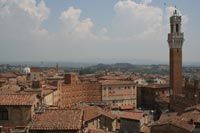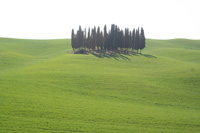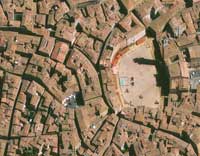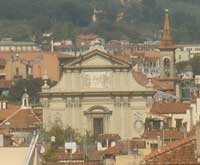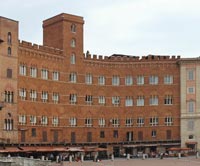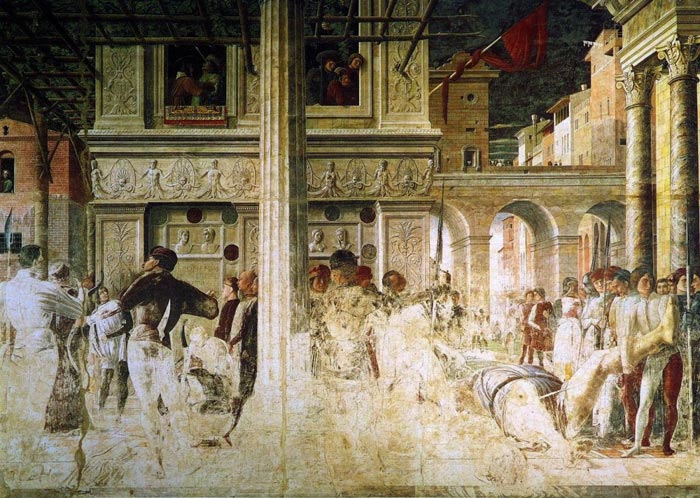 |
The Lamentation over the Dead Christ, Tempera on canvas, 68x81 cm, 1490, Pinacoteca di Brera, Milan. |
| Andrea Mantegna |
Andrea Mantegna (c. 1431 – September 13, 1506) was a North Italian Renaissance painter of well regarded influence, who was known for his visual experiments in perspective and spatial illusion. Much of his ambitious life as an artist branched off after leaving his birth home of Padua, in Venice. Before that he was under the tutelage of another Paduan painter Francesco Squarcione (1397 - 1468) at eleven years old and was influenced by Squarcione’s love of ancient Roman art. Although a favorite student of Squarcione, Mantegna became disgruntled at his teacher profiting off work he had done. It was then, at the age of seventeen that he left Padua, never to return, exploring his ambitions in Verona, Mantua, Rome and possibly Venice and Florence. [1] His early work in Padua included an altarpiece for the church of Santa Sofia (1448) and decorations for the Ovetari Chapel in the church of Eremitani. Most of these works were lost during 1944 due to World War II bombings. |
Andrea Mantegna, |
||
|
|
Profile portraits. Detail of fresco Martyrdom of St. Christophor in the Cappella Ovetari, Padua. According to Vasari - painter's friends: Onofrio (Nofri) Strozzi (Palla Strozzi's son), doctor Girolamo della Valle and lawyer Bonifaccio Frugimelica |
|
|
Giuseppe Fiocco, Mantegna, la Cappella Ovetari nella Chiesa degli Eremitani, 1947, A. Pizzi in Milano. |
||
Art in Tuscany | Giorgio Vasari's Lives of the Artists | Andrea Mantegna Giorgio Vasari | Le vite de' più eccellenti architetti, pittori, et scultori italiani, da Cimabue insino a' tempi nostri | Andrea Mantegna This page uses material from the Wikipedia articles Andrea Mantegna and Cappella Ovetari, published under the GNU Free Documentation License. Wikimedia Commons has media related to: Cappella Ovetari. |
||
Holiday homes in the Tuscan Maremma | Podere Santa Pia |
||||
Siena |
Podere Santa Pia |
Podere Santa Pia, garden |
||
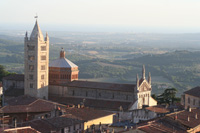 |
||||
Val d'Orcia" tra Montalcino Pienza e San Quirico d’Orcia. |
Siena, Piazza del Campo |
Massa Marittima |
||
San Marco a Firenze |
Siena, Palazzo Sansedoni |
Firenze, Duomo |
||
| Chiesa degli Eremitani and Museo Civico Eremitani |
||||
| The Church of the Eremitani is a former Augustinian church, built from 1276 to 1306 and dedicated to St. Philip and St. James. The original roof was built in 1306 by Fra Giovanni degli Eremitani. The church was nearly destroyed during the 1944 aerial bombing, when most of the valuable frescoes were lost, and what can be seen today are the remains of the original building that have been restored after the Second World War. It contains a beautiful wooden ceiling and a number of monumental tombs, among which especially notable are the tomb of Marco Benavides by the Florentine architect Ammannati, and those of Jacopo and Ubertinelo da Carrara, lords of Padua. The chapel of St. James and St. Christopher used to be illustrated by frescoes of Andrea Mantegna, famous Italian Renaissance artist. The surviving remains of Mantegna's celebrated frescoes, "The Martyrdom of St. James" and "The Martyrdom of St. Christopher" are kept in the Cappella Ovetari. Other remaining frescoes in the church are those of Guariento and Ansuino da Forli. The Museo Civico Eremitani is housed in the beautifully restored rooms of the old monastery. The ground floor houses the Archaeological section, featuring Etruscan, Egyptian and Roman antiquities, offering an insight into the city's Roman Palaeovenetian history. Some of the highlights of this rich collection of artifacts include rare Roman medallions and tombs, life-size statues and fine mosaics and a set of Venetian coins. The upstairs art gallery displays a collection of paintings by the great Italian masters from the Venetian and Flemish schools, spanning the period from the early 15th century to the 19th century. The collection contains works by Giotto, Titian, Tiepolo, Guariento, Bellini, Veronese and Tintoretto. The highlights of the collection displayed in the gallery are Tintoretto's Crucifixion, Giorgione's Leda and the Swan, Giotto's beautiful wooden Crucifix and Bellini's Portrait of the Young Senator. |
||||

